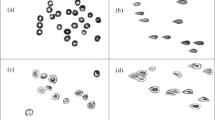Abstract
We investigated the effects of the H2S and CO gasomediators on Ca2+-dependent potassium channels and an anion exchanger, which participate in the induction of the hyperpolarization response of the erythrocyte membrane and play an important role in regulation of the volume and deformability of erythrocytes. We showed that in the presence of H2S and CO donors, the amplitude of the redox-stimulated membrane hyperpolarization decreased significantly due to a decrease in the activity of Ca2+-dependent potassium channels. It was found that H2S and CO eliminate the compression of erythrocytes observed during activation of Ca2+-dependent potassium channels or inhibition of the anion exchanger. It was shown that the H2S donor significantly increases the erythrocyte deformability.


Similar content being viewed by others
REFERENCES
R. Huisjes, A. Bogdanova, W. W. van Solinge, et al., Front. Physiol. 9, 656 (2018).
H. Guizouarn, N. Gabillat, R. Motais, and F. Borgese, J. Physiol. 535 (Pt 2), 497 (2001).
A. Bogdanova, A. Makhro, J. Wang, et al., Int. J. Mol. Sci. 14, 9848 (2013).
A. D. Maher and P. W. Kuchel, Int. J. Biochem. Cell Biol. 35 (8), 1182 (2003).
F. Lang, E. Lang, and M. Foller, Transfus. Med. Hemother. 39 (5), 308 (2012).
S. L. Thomas, G. Bouyer, A. Cueff, et al., Blood Cells Mol. Dis. 46 (4), 261 (2011).
J. S. Gibson, A. R. Cossins, and J. C. Ellory, J. Exp. Biol. 203 (9), 1395 (2000).
A. Bogdanova, M. Berenbrink, and M. Nikinmaa, Acta Physiol. 195, 305 (2009).
S. V. Gusakova, I. V. Kovalev, Y. G. Birulina, et al., Biophysics 62 (2), 220 (2017).
E. Dongo, G. Beliczai-Marosi, A. S. Dybvig, and L. Kiss, Nitric Oxide 81, 75 (2018).
I. Barbagallo, G. Marrazzo, A. Frigiola, et al., Curr. Pharm. Biotechnol. 13 (6), 787 (2012).
I. Bernhardt and J. C. Ellory, Red Cell Membrane Transport in Health and Disease (Springer, Berlin, 2013).
S. P. Srinivas, J. A. Bonanno, E. Lariviere, et al., Pflugers Arch. 447 (1), 97 (2003).
S. Shin, Y. Ku, M. S. Park, and J. S. Suh, Korea Aust. Rheol, J. 16 (2), 85 (2004).
A. C. Kalli and R. A. F. Reithmeier, PLOS Comput. Biol. 14 (7), 1 (2018).
A. A. Platonova, S. V. Koltsova, G. V. Maksimov, et al., Biophysics (Moscow) 58 (3), 389 (2013).
A. V. Sitozhevsky, I. V. Petrova, S. V. Kremeno, et al., Rozz. Fiziol. Zh. im. I. N. Sechenova 92 (4), 461 (2006).
Y. Yang, X. Jin, and C. Jiang, Antioxid. Redox Signal. 20 (6), 937 (2014).
B. Del Carlo, M. Pellegrini, and M. Pellegrino, Biochim. Biophys. Acta 1612 (1): 107 (2003).
C. L. Bianco, A. Savitsky, M. Feelisch, and M. M. Cortese-Krott, Biochem. Pharmacol. 149, 163 (2018).
M. L. Jennings, Am. J. Physiol. Cell Physiol. 305, C941 (2013).
Y. V. Kucherenko, L. Wagner-Britz, I. Bernhardt, and F. Lang, J. Membr. Biol. 246 (4), 315 (2013).
E. Lang, S. M. Qadri, K. Jilani, et al. Basic Clin. Pharmacol. Toxicol. 111 (5), 348 (2012).
S. N. Orlov, I. V. Petrova, N. I. Pokudin, et al., Biol. Membrany 9 (9), 885 (1992).
A. Dyrda, U. Cytlak, A. Ciuraszkiewicz, et al., PLoS One 5 (2), e9447 (2010).
Funding
This study was carried out with financial support from the Russian Foundation for Basic Research (within the framework of scientific project no. 19-415-703015) and the Council for Grants of the President of the Russian Federation (grant MK-143.2020.4).
Author information
Authors and Affiliations
Corresponding author
Ethics declarations
CONFLICT OF INTERESTS
The authors declare no conflicts of interest.
COMPLIANCE WITH ETHICAL STANDARDS
This work followed the ethical standards developed in accordance with the Declaration of Helsinki (as amended in 2013) and the Rules of Good Clinical Practice (order of the Ministry of Health of the Russian Federation of 01.04.2016). All individuals participating in the study gave informed consent.
Additional information
Translated by I. Shipounova
Abbreviations: КСа-channels, Са2+-dependent potassium channels; PMS, phenazine metasulfate; CORM-2, tricarbonyldichlororuthenium(II) dimer; HR, hyperpolarizing response.
Rights and permissions
About this article
Cite this article
Petrova, I.V., Birulina, Y.G., Belyaeva, S.N. et al. The Effects of Gasomediators on the Са2+-Dependent Potassium Permeability of the Erythrocyte Membrane. BIOPHYSICS 65, 614–618 (2020). https://doi.org/10.1134/S0006350920040156
Received:
Revised:
Accepted:
Published:
Issue Date:
DOI: https://doi.org/10.1134/S0006350920040156




